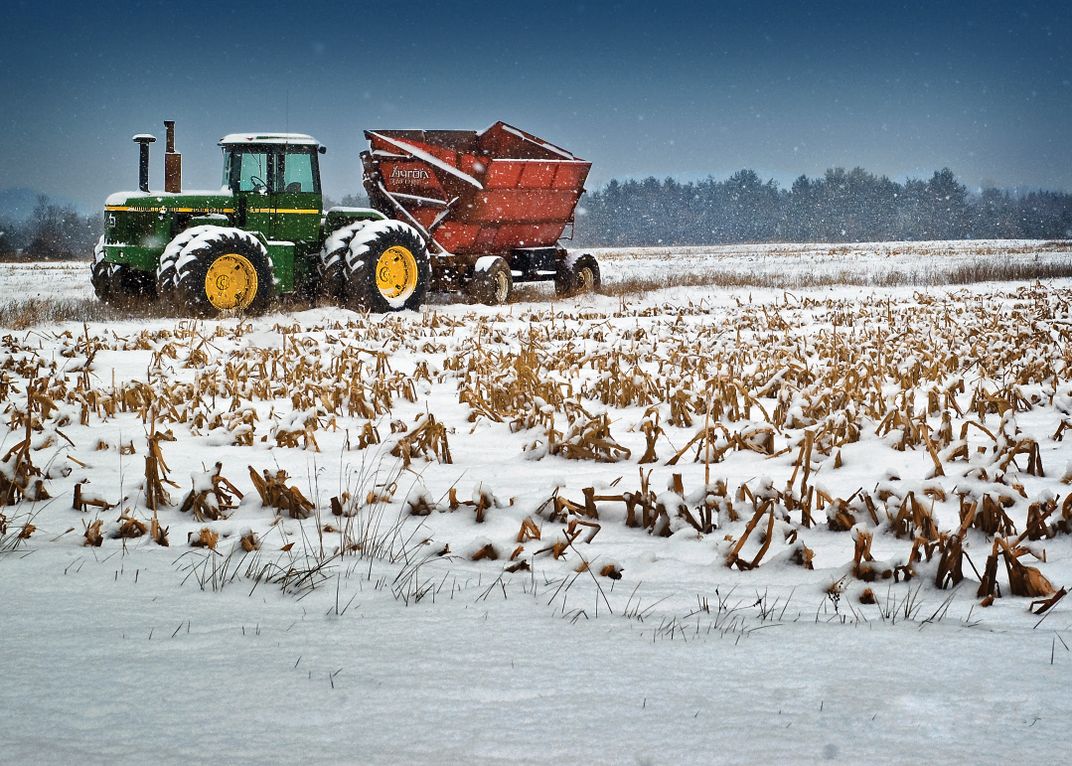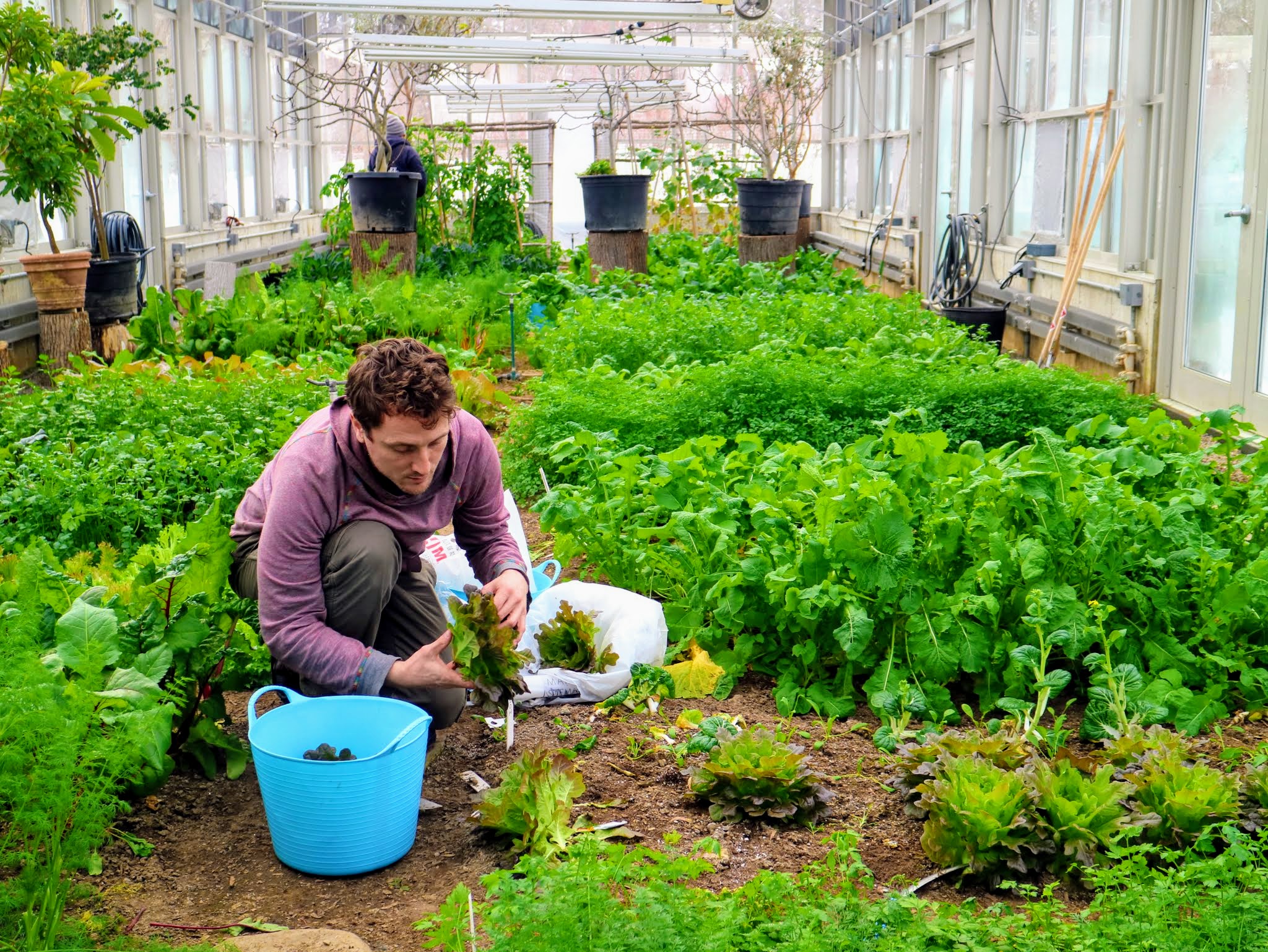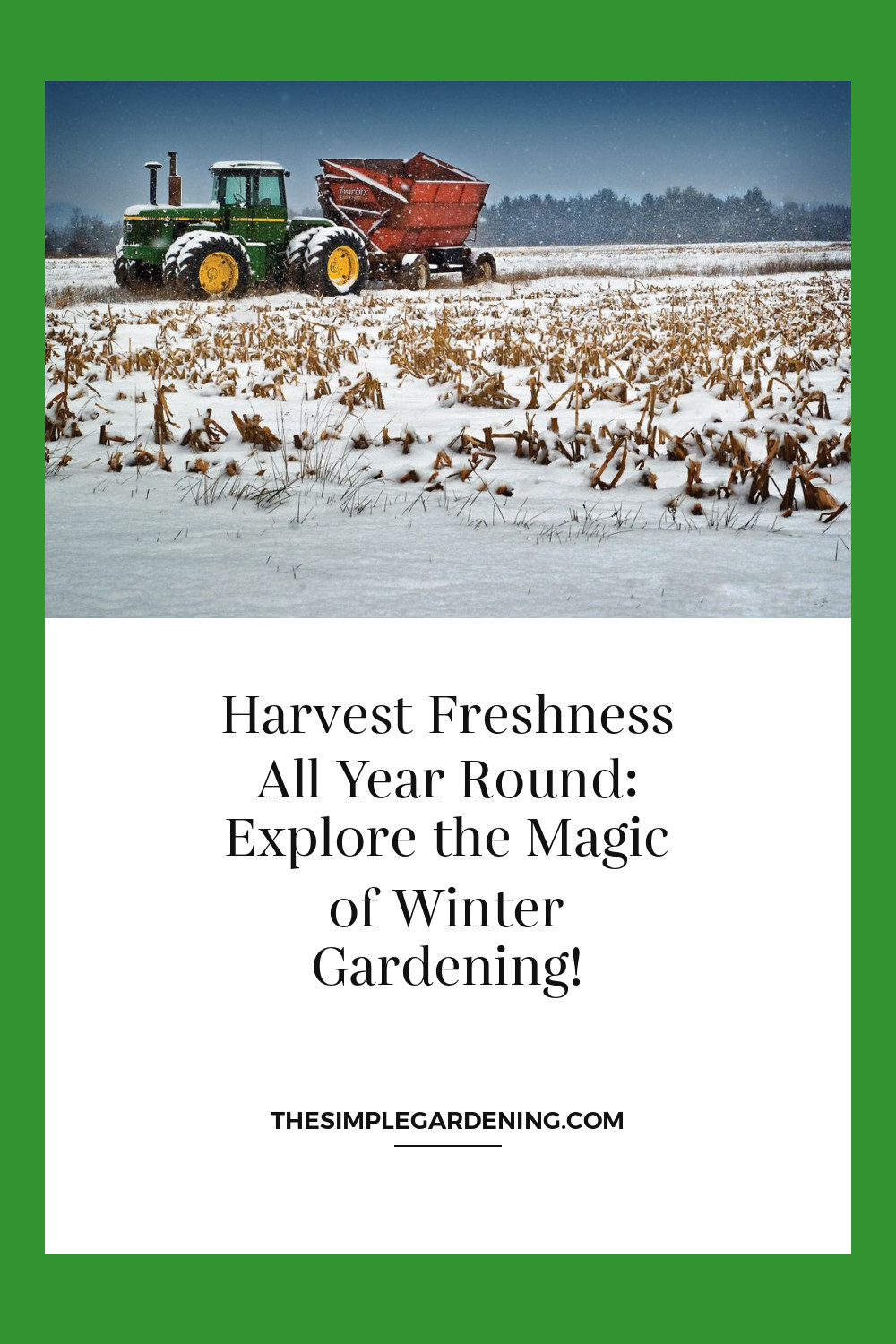Winter gardening might sound like an oxymoron to some, but for seasoned gardeners, it’s a thrilling challenge and a delightful way to extend the harvest season. Imagine savoring fresh, homegrown vegetables in the heart of winter, knowing they’ve thrived despite the cold. This article will guide you through the enchanting world of winter gardening, ensuring your garden remains productive even when the frost sets in. Ready to turn your garden into a winter wonderland of harvests? Let’s dive in!
I. Introduction to Winter Harvesting
Overview of Winter Gardening Practices
Winter gardening isn’t just about braving the cold; it’s about embracing it. Many vegetables and herbs can thrive in colder temperatures, provided you give them the right conditions.
| Practice | Description | Benefits |
|---|---|---|
| Cold Frames | Small, transparent enclosures for plants. | Extend the growing season by providing warmth. |
| Hoop Houses | Semi-circular structures covered with plastic. | Protect plants from harsh weather. |
| Row Covers | Lightweight fabric draped over crops. | Insulate plants and protect from frost. |
| Mulching | Adding a layer of organic material to soil. | Retains moisture and regulates soil temperature. |
Winter gardening practices revolve around protecting plants from the worst of the weather while taking advantage of the unique conditions that winter offers.
Benefits of Harvesting During the Winter Months
Why bother with winter gardening when you could simply hibernate until spring? Well, the benefits are plentiful:
- Extended Harvest: Fresh produce available throughout the year.
- Improved Flavor: Cold temperatures can enhance the sweetness of certain vegetables.
- Pest Control: Fewer pests to deal with in colder months.
- Health Benefits: Fresh, nutrient-rich produce even in winter.
- Cost Savings: Reduced grocery bills with homegrown veggies.

Source Image: photocontest.smithsonianmag.com
II. Understanding Winter-Hardy Crops
Types of Vegetables and Herbs Suitable for Winter Harvesting
Not all plants are cut out for winter. Here are some winter warriors that thrive in the cold:
| Vegetables | Herbs |
|---|---|
| Kale | Thyme |
| Carrots | Rosemary |
| Brussels Sprouts | Sage |
| Leeks | Oregano |
| Spinach | Chives |
These hardy crops can withstand frost and even improve in flavor after a cold snap.
Cold-Tolerant Varieties and Cultivars
Within each type of winter crop, certain varieties stand out for their cold tolerance:
- Kale: Varieties like ‘Winterbor’ and ‘Red Russian’ are exceptionally hardy.
- Carrots: ‘Nantes’ and ‘Danvers’ can survive cold temperatures well.
- Spinach: ‘Bloomsdale Long Standing’ is known for its cold resistance.
- Leeks: ‘Bandit’ and ‘Tadorna’ thrive in the cold.
- Brussels Sprouts: ‘Dagan’ and ‘Gustus’ are ideal for winter gardening.
III. Planning Your Winter Garden for Harvest
Selecting Cold-Resistant Plants for Winter Growth
Choosing the right plants is crucial. Here’s a quick reference table:
| Plant | Optimal Planting Time | Cold Hardiness |
|---|---|---|
| Kale | Late summer | Very High |
| Carrots | Late summer/early fall | High |
| Brussels Sprouts | Late summer | Very High |
| Leeks | Early fall | High |
| Spinach | Late summer | High |
Selecting plants with proven cold resistance ensures a successful winter harvest.
Scheduling Planting Dates for Winter Harvesting
Timing is everything. Plant too early, and your crops may bolt; plant too late, and they might not mature before the deep freeze.
Planting Schedule Example:
| Crop | Planting Date | Harvest Time |
|---|---|---|
| Kale | Late August | Throughout Winter |
| Carrots | Early September | Late Fall to Winter |
| Brussels Sprouts | Mid-August | Late Fall to Winter |
| Leeks | Early September | Late Fall to Winter |
| Spinach | Late August | Throughout Winter |
This schedule helps ensure your crops are ready for the winter harvest.

Source Image: www.youtube.com
IV. Extending the Growing Season with Protective Structures
Using Cold Frames, Hoop Houses, and Row Covers
Protective structures are your best friends in winter gardening. They act like mini-greenhouses, trapping heat and protecting plants from frost.
| Structure | Benefits | Best Crops to Use With |
|---|---|---|
| Cold Frames | Easy to construct, inexpensive | Leafy greens, herbs |
| Hoop Houses | Larger, more durable, versatile | Root vegetables, leafy greens |
| Row Covers | Lightweight, easy to install | Various vegetables |
Each structure has its own advantages, so choose based on your garden’s needs.
Maximizing Sunlight Exposure for Winter Vegetables
Sunlight is scarcer in winter, so make the most of what you get:
- South-Facing Gardens: Plant where sunlight is most abundant.
- Reflective Surfaces: Use materials like aluminum foil to reflect light onto plants.
- Pruning: Trim back any nearby trees or shrubs that may block sunlight.
V. Cold Weather Harvesting Techniques
Strategies for Harvesting in Freezing Temperatures
Harvesting in the cold requires some finesse:
| Technique | Description | Benefits |
|---|---|---|
| Partial Harvesting | Harvest only what you need | Reduces plant stress |
| Thaw Before Harvest | Allow crops to thaw before picking | Prevents damage to produce |
| Morning Harvest | Harvest in the morning after thaw | Ensures best quality |
These strategies help maintain the quality and longevity of your produce.
Preserving Freshness and Flavor of Winter Produce
Keeping your winter harvest fresh is just as important as growing it:
- Cool, Dark Storage: Store root vegetables in cool, dark places.
- Hydration: Keep leafy greens moist by wrapping in damp cloth.
- Frequent Checks: Regularly check stored produce for signs of spoilage.

Source Image: www.midwestfarmreport.com
VI. Proper Storage of Winter Harvested Crops
Cold Storage Options for Root Vegetables
Root vegetables can be stored in various ways to prolong their freshness:
| Storage Method | Description | Best For |
|---|---|---|
| Root Cellars | Underground storage, stable temperature | Carrots, beets, potatoes |
| Refrigeration | Standard fridge storage | Short-term storage |
| Sand Boxes | Burying in sand for moisture control | Carrots, parsnips |
These methods help keep your root vegetables fresh for longer periods.
Indoor Storage Techniques for Leafy Greens and Herbs
Leafy greens and herbs require different storage techniques:
| Technique | Description | Benefits |
|---|---|---|
| Crisper Drawers | Store in refrigerator crisper drawers | Maintains humidity |
| Herb Bundles | Hang herbs upside down to dry | Easy, natural drying |
| Freezing | Freeze herbs in ice cube trays with water | Long-term preservation |
Proper storage ensures that your leafy greens and herbs remain fresh and flavorful.
VII. Winter Harvesting in Different Climate Zones
Adapting Techniques for Cold, Temperate, and Mild Climates
Winter gardening techniques vary based on your climate zone:
| Climate Zone | Techniques | Example Crops |
|---|---|---|
| Cold | Heavy mulching, thick row covers | Kale, Brussels sprouts |
| Temperate | Cold frames, moderate row covers | Carrots, leeks |
| Mild | Light row covers, minimal protection | Spinach, herbs |
Adapting your techniques ensures a successful harvest regardless of your location.
Overcoming Challenges in Extreme Winter Conditions
Winter gardening in extreme conditions requires extra effort:
- Double Layers: Use multiple layers of row covers.
- Windbreaks: Install barriers to protect against harsh winds.
- Heat Sources: Use heat lamps or heated mats in severe cold.
These strategies help combat extreme winter conditions and protect your crops.

Source Image: www.youtube.com
Winter Harvesting
VIII. Seasonal Eating and Cooking with Winter Harvested Produce
Recipes and Meal Ideas Using Winter Vegetables and Herbs
Winter vegetables can be the star of many delicious dishes:
| Dish | Key Ingredients | Preparation Time |
|---|---|---|
| Winter Salad | Kale, carrots, herbs | 20 minutes |
| Root Vegetable Stew | Carrots, potatoes, leeks | 1 hour |
| Herb-Infused Roast | Brussels sprouts, rosemary | 45 minutes |
These recipes make the most of your winter harvest, providing warmth and nutrition.
Incorporating Freshness and Flavor into Winter Dishes
Enhance the flavor of your dishes with fresh, homegrown produce:
- Herb Garnishes: Fresh herbs add a burst of flavor.
- Roasting: Roasting brings out the natural sweetness of vegetables.
- Salads: Raw vegetables retain their crispness and nutritional value.

Source Image: www.themarthablog.com
IX. Utilizing Perennial Crops for Winter Harvesting
Harvesting from Perennial Vegetables and Herbs
Perennials provide a reliable source of produce year after year:
| Perennial Crop | Harvesting Time | Care Tips |
|---|---|---|
| Asparagus | Early spring to fall | Mulch heavily in winter |
| Rhubarb | Spring to early summer | Protect crown from frost |
| Chives | Year-round | Harvest regularly to promote growth |
These perennials can be a cornerstone of your winter garden.
Benefits of Perennial Crops in Winter Gardening
Perennials offer several advantages:
- Low Maintenance: Less replanting each year.
- Early Harvests: Many perennials are ready before annuals.
- Soil Health: Perennials help maintain soil structure and health.

Source Image: www.familyfoodgarden.com
X. Succession Planting for Continuous Winter Harvest
Planning Successive Plantings for Continuous Yield
Succession planting ensures a steady supply of produce:
| Crop | First Planting Date | Successive Planting Interval |
|---|---|---|
| Kale | Late August | Every 3 weeks |
| Spinach | Late August | Every 2 weeks |
| Carrots | Early September | Every 3 weeks |
This method keeps your garden productive throughout winter.
Rotating Crops to Optimize Winter Harvests
Crop rotation prevents soil depletion and pest buildup:
- Leafy Greens After Roots: Follow root crops with leafy greens.
- Legumes: Plant legumes to enrich the soil with nitrogen.
- Brassicas: Rotate brassicas to prevent pest issues.
XI. Protecting Winter Harvests from Pests and Diseases
Preventing Common Winter Pests and Diseases
Even in winter, pests and diseases can be a problem:
| Pest/Disease | Prevention Method | Best Practices |
|---|---|---|
| Aphids | Row covers, insecticidal soap | Regular inspection |
| Powdery Mildew | Proper spacing, good air circulation | Water in the morning |
| Slugs and Snails | Beer traps, diatomaceous earth | Clear debris |
Preventative measures ensure your winter harvest stays healthy.
Organic Pest Control Methods for Winter Gardening
Organic methods keep your garden chemical-free:
- Neem Oil: Effective against many pests.
- Beneficial Insects: Ladybugs and predatory beetles.
- Companion Planting: Planting garlic or chives to repel pests.

Source Image: savvygardening.com
Winter Harvesting
XII. Winter Harvesting in Container Gardens
Growing Cold-Tolerant Crops in Containers
Container gardening is flexible and convenient:
| Crop | Container Size (inches) | Cold Tolerance |
|---|---|---|
| Kale | 12 | Very High |
| Spinach | 8 | High |
| Carrots | 10 | High |
Choose the right container size for optimal growth.
Strategies for Protecting Container Plants from Frost
Containers need extra protection in winter:
- Insulation: Wrap containers in bubble wrap.
- Mobility: Move containers to sheltered locations.
- Mulching: Add a layer of mulch to insulate roots.
XIII. Community and Urban Winter Gardening Initiatives
Collaborative Efforts to Extend the Growing Season
Community gardens can thrive even in winter:
| Initiative | Description | Benefits |
|---|---|---|
| Shared Hoop Houses | Communal structures for winter gardening | Shared resources, extended season |
| Winter Workshops | Educational events on winter gardening | Knowledge sharing, community building |
| Seed Exchanges | Swapping winter-hardy seeds | Greater crop diversity |
Collaborative efforts make winter gardening accessible to more people.
Urban Gardening Projects Focused on Winter Harvesting
Urban gardening initiatives can bring green to city winters:
- Rooftop Gardens: Utilizing unused space for winter crops.
- Indoor Hydroponics: Growing vegetables indoors using hydroponic systems.
- Community Greenhouses: Shared spaces for winter gardening.

Source Image: gardenandhappy.com
XIV. Educational Outreach on Winter Gardening and Harvesting
Workshops and Resources for Learning About Winter Gardening
Education is key to successful winter gardening:
| Resource | Description | Availability |
|---|---|---|
| Local Workshops | Hands-on learning experiences | Community centers, schools |
| Online Courses | Comprehensive guides to winter gardening | Websites, educational platforms |
| Gardening Books | Detailed information and techniques | Libraries, bookstores |
These resources provide valuable knowledge for gardeners of all levels.
Sharing Knowledge and Experiences with Winter Harvesting
Experienced gardeners can mentor others:
- Community Groups: Join local gardening clubs.
- Online Forums: Participate in gardening discussions.
- Social Media: Share tips and experiences on platforms like Instagram and Pinterest.
XV. Future Trends in Winter Gardening and Harvesting
Innovations in Cold-Resistant Crop Varieties
Breeding efforts are producing more resilient crops:
| Innovation | Description | Benefits |
|---|---|---|
| Cold-Resistant Hybrids | New varieties with improved cold tolerance | Higher yields, better flavor |
| Genetic Research | Understanding plant resilience | More targeted breeding |
| Sustainable Practices | Organic methods for winter gardening | Healthier crops, better environment |
These innovations promise exciting advancements in winter gardening.
Sustainable Practices for Winter Gardening in a Changing Climate
Sustainability is crucial as climate patterns shift:
- Water Conservation: Efficient irrigation systems.
- Soil Health: Use of organic fertilizers and compost.
- Energy Efficiency: Solar-powered garden lights and heaters.
Embracing these practices ensures a greener, more sustainable future for winter gardening.

